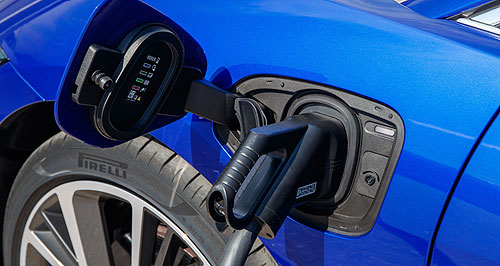IF BROUGHT into power at the next federal election, Australian Labor Party (ALP) leader Bill Shorten is promising to bring the country in line with the rest of the world for electric vehicle (EV) take-up through a National Electric Vehicle policy.
Proposed as part of the Climate Change Action Plan, the ALP will set a 2030 national EV fleet target of half of all new vehicles, while the same percentage will be expected of government fleets five years earlier, in 2025.
However, it remains unclear if the figure also incorporates hybrids such as the Toyota Prius and plug-in hybrids like the Mitsubishi Outlander PHEV, or if it applies solely to emissions-free models like the Nissan Leaf.
If Australian new-vehicle sales remain steady for the next decade, by 2030, nearly 600,000 EVs could be sold annually.
To accelerate the growth of private EV uptake, a financial incentive will be introduced for businesses which allow an immediate deduction of 20 per cent off any new EV priced above $20,000.
The Labor government will also mandate that all federally funded road upgrades take into consideration charging infrastructure, while also working with states to “ensure new an refurbished commercial and residential developments include EV charging capacity”.
Projections from Price Waterhouse Coopers peg up to $2.9 billion could be injected into the economy if the 50 per cent uptake figure can be achieved by the end of the next decade, as well as creating around 13,400 jobs.
Although a clear timeline is yet to be determined, Labor is also proposing a vehicle emissions standard of 105 grams of CO2 per kilometre for light vehicles, the same figure used by the US, that will be applied to the vehicle retailer, not manufacturer.
Labor’s plan says: “This will allow retailers to meet the standards by offsetting high-emissions car sales with low- or zero-emissions car sales.”
For reference, the entry-level Toyota Corolla – Australia’s best-selling passenger nameplate – with a 2.0-litre four-cylinder engine emits 148g/km of CO2 on the combined cycle.
Aside from passenger vehicles, the ALP also sees a refresh of Australia’s truck fleet and improved public transportation networks as means of lowering the country’s emissions, which make up almost 20 per cent of air pollutants.
Across the automotive industry, many have voiced their support for the ALP’s plans, including the Federal Chamber of Automotive Industries (FCAI), Australian Automobile Association (AAA) and Australian Automotive Dealer Association (AADA).
FCAI chief executive Tony Weber said Labor’s National Electric Vehicle policy will need careful planning with many facets of the automotive industry to pull off correctly.
“We have been calling for the implementation of an achievable emissions target for some time, so we welcome the opportunity to discuss this in more detail,” he said. “The key is to implement achievable emissions targets, designed in consultation with industry, as part of the transport sector’s contribution to lower overall emissions.
“A well thought-out introductory plan that includes tariff and tax relief, financial and non-financial incentives, and the provision of comprehensive infrastructure will need to be implemented if the targets are to be achieved.”
Meanwhile, the AAA released a statement that called for bipartisan support for stricter emissions standards and higher-quality fuels in Australia.
“The AAA supports the introduction of an emissions standard that recognises the unique needs and preferences of Australian motorists, and the fuel quality available to them,” it said.
“However, a poorly designed standard will drive up the cost of cars, the cost of petrol, and significantly curtail the availability of popular vehicle makes and classes, which is why the AAA expects both sides of politics to clearly articulate their vehicle emissions targets and timelines ahead of the election.”
As for EVs, the AAA said it “believes that government support should be aimed at reducing regulatory barriers to uptake and use of low-cost measures to stimulate initial market demand”, while also stating that it believes incentives should apply to “ultra-low fuel consumption (below two litres per 100km)” vehicles.
Finally, AADA CEO David Blackhall warned that the onus of vehicle emissions standards should fall to the car-makers, not the car sellers.
“We accept the opposition’s invitation to consult on the timeline and coverage of vehicle emissions standards but are concerned over the reference to these standards applying to car retailers,” he said.
“In the US and the EU, it is the manufacturer not the retailer that needs to adhere to vehicle emissions standards.
“Dealers have limited influence over the product mix and the decision as to what cars are imported into Australia is entirely at the discretion of the manufacturers. In the end, dealers can only sell cars supplied to them.”
Last week, the Australian Greens party also outlined its vision for Australia’s automotive future, which includes a 17 per cent luxury fossil-fuel car tax before a ban of all new internal-combustion vehicle sales by 2030.













Facebook Twitter Instagram